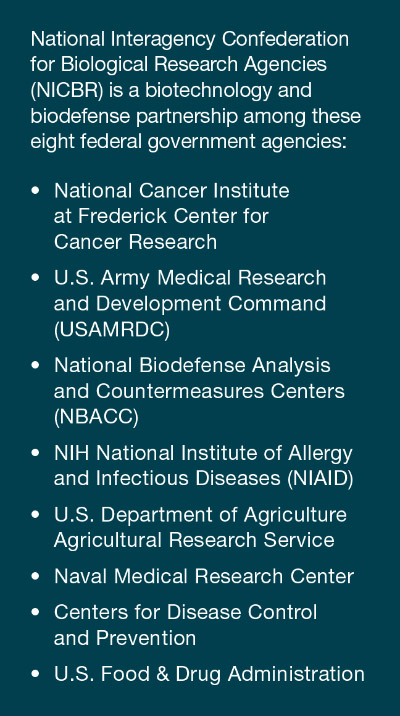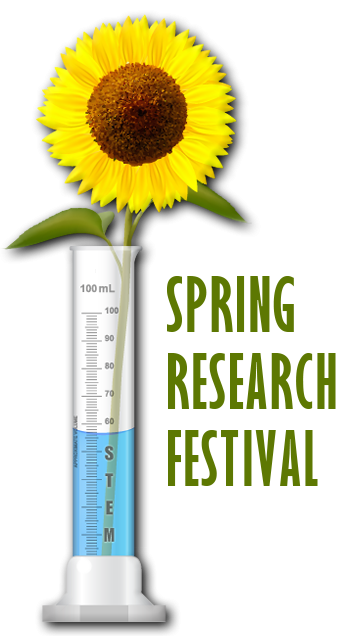One of the annual rites of spring at the National Cancer Institute at Frederick returned in April, when hundreds of members of the Ft. Detrick and Frederick National Laboratory community participated in the virtual Spring Research Festival. The event was co-sponsored by the United States Army Medical Research and Development Command (USAMRDC) and the Military & Health Research Foundation (MHRF). Representatives from the National Interagency Confederation for Biological Research (NICBR) participated in the festival, which highlights scientific research and innovation.
 Over the course of two days, participants had the opportunity to listen and submit questions to online keynote presentations by leading scientists from NASA and the U.S. Food & Drug Administration (FDA), while also engaging with their peers through poster presentations and displays. The Young Investigator Symposium enabled researchers to share their studies and findings, while the Collaborative Research Opportunity Showcase demonstrated the ways in which different agencies can complement each other’s work to advance everything from bioforensics to medical readiness and infectious disease control for soldiers in the field.
Over the course of two days, participants had the opportunity to listen and submit questions to online keynote presentations by leading scientists from NASA and the U.S. Food & Drug Administration (FDA), while also engaging with their peers through poster presentations and displays. The Young Investigator Symposium enabled researchers to share their studies and findings, while the Collaborative Research Opportunity Showcase demonstrated the ways in which different agencies can complement each other’s work to advance everything from bioforensics to medical readiness and infectious disease control for soldiers in the field.
From Outer Space to Safe Spaces on Earth
The event began with a keynote presentation by Alvin Smith, Ph.D., PMP, manager of the Planetary Protection Center of Excellence at NASA’s Jet Propulsion Laboratory. In addressing “Considerations for Backward Planetary Protection in Mars Sample Return Planning: Biological Safety from Flight to Facilities,” Dr. Smith noted that preparations to return to Earth samples collected from the surface of Mars entail many of the same safety concerns researchers in USARMDC face in their work. This includes the need to place samples in quarantine containment until proven safe by analysis or sterilization to avoid contamination by potentially deadly pathogens that exist on the Red Planet.
During a Q&A with Smith, one participant wondered about the risks associated with bringing to Earth potential dangers from outer space. “The best science and best instruments can really only be achieved with interstellar labs,” Smith said. “The risk will never be zero, but we can do our due diligence to mitigate every risk we can.”
Poster Blitz
Following Dr. Smith’s presentation, close to 100 virtual attendees listened and watched as 15 researchers submitted their scientific findings during the Poster Blitz. With only five minutes to present an overview of their work, the poster presenters covered a wide range of topics, including immunology, drug delivery, and cancer biology.
The posters were judged on four main criteria, including research concept, experimental quality, display attributes (tables, figures, photos, color), and overall quality and presentation.
Four of the five winning posters were presented by researchers from NCI Frederick:
- 1st Place: Shreya Kordale, NCI: “Genome-wide CRISPR Screening to Uncover Alternative Splicing Regulatory Networks”
- 2nd Place: Eva Agostino, NCI: “Inhibition of Neutral Sphingomyelinase 2 Blocks HIV-1 Maturation and Replication”
- 3rd Place: Ruby Schnirman, NCI: “Msgn1 regulates ingression, migration, and differentiation of mesodermal progenitors to coordinate cell fate decisions and axial extension”
- 4th Place: Lucy Stewart, USDA: “Development of virus-based tools for gene expression and gene silencing in maize”
- 5th Place: Sneha Anmalsetty, NCI: “COX2, NOS2, and the Spatial Organization of Epithelial-to-Mesenchymal Transition in an in vitro model of a Hypoxic Tumor Microenvironment”
In all, 49 posters were displayed throughout the festival, showcasing the innovative science and ground-breaking findings that occur in laboratories throughout NCI Frederick.
Closing out the events for day one of the festival was the Young Investigators Symposium. This event challenged six young scientists to present their research and its impact in a traditional 15 minute lecture format (12 minute lecture and three minutes for questions). Recognized by a panel of three judges for their work were:
- 1st Place: Antonia Santoro, M.A., U.S. Army Medical Research Institute of Chemical Defense: “Dexmedetomidine as a Countermeasure for Nerve Agent Poisoning”
- 2nd Place: Anthony R. Mele, Ph.D., Laboratory of Human Retrovirology and Immuneoinformatics, FNLCR: “Dendritic Cells Exposed to IL-27 Release Less HIV-1 Virions Due to Expression of a Novel Host Factor Ankyrin Repeat Domain 22 (ANKRD22)
“An Incredibly Exciting Area”
Peter Marks, M.D., Ph.D., director of the FDA’s Center for Biologics Evaluation and Research was the festival’s day two keynote presenter. Speaking on the topic of “Advancing the Development of Cell and Gene Therapies,” Dr. Marks noted that the FDA is seeing an increasing number of applications for gene and cell therapies, with eight cell therapies currently approved, including four for non-Hodgkin’s lymphoma and two for multiple melanoma.
“This is an incredibly exciting area, and the FDA is committed to moving it forward,” Marks said. But he acknowledged that the biggest challenge remains the costs associated with manufacturing small batches of gene therapies. To facilitate further development of safe and effective cell and gene therapies, Marks said the FDA is committed to deploying all applicable development programs. “When things really work in gene therapy it can be quite striking,” he said. “That is why it is our goal to help as many people as possible.”
The festival’s final event was the Collaborative Research Opportunity Showcase, which drew more than 50 virtual attendees. They listened to NICBR representatives provide overviews of their research projects and share opportunities for collaboration, including research awards.
By applying their specific expertise to issues such as how to battle emerging pathogens that may infect soldiers on the battlefield to protecting civilian commercial aviation and food supply chains, the presenters demonstrated that although at first glance some of their missions may seem remotely related, there are many opportunities to collaborate and benefit from each other’s knowledge and expertise.


